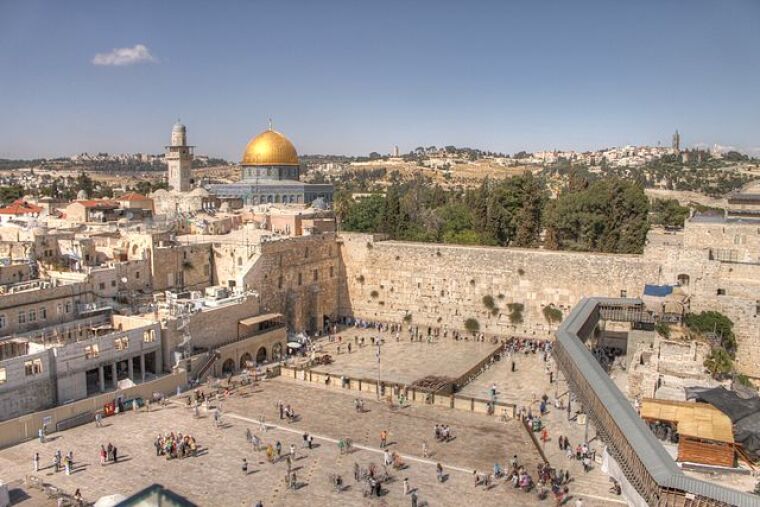Archaeologists unveil 2,700-year-old seal impression that confirms existence of biblical Jerusalem governor

Israeli archaeologists have unveiled an extremely rare seal impression that is said to belong to the biblical Governor of Jerusalem during the First Temple era.
The 2,700-year-old seal, which was discovered in Jerusalem's Western Wall plaza, bears the inscription "Belonging to the governor of the city."
"This is the first time that such an impression was found in an authorized excavation. It supports the biblical rendering of the existence of a governor of the city in Jerusalem 2,700 years ago," site excavator Dr. Shlomit Weksler-Bdolah said.
Haaretz noted that many seal impressions and seals have been found in ancient Jerusalem, including in the Temple Mount, but researchers said that the latest find, a clay measuring 1.3 by 1.5 centimeters in size and just over two millimeters thick, is unique in being of unquestionable provenance.
"Ours is special because this was the first time the seal of the Governor of the City of Jerusalem itself was found in the right place," Weksler-Bdolah remarked.
The seal impression features two standing figures facing each other, though their potential identities are not known as the heads are depicted as dots with no special features. The two figures were said to be wearing striped garments reaching down to their knees.
The governor of Jerusalem is referenced twice in the Hebrew Bible. The book of 2 Kings lists Joshua as the governor of the city during the reign of Hezekiah, while 2 Chronicles stated that the post was held by Maaseiah during the days of Josiah.
According to Times of Israel, the artifact was found while researchers were conducting an examination of the dust from a First Temple structure 100 meters northwest of the Western Wall at a site that archaeologists have been excavating since 2005.
During the excavations, the archaeologists discovered a massive Iron Age four-room building where they found an eclectic collection of six other seals, which points to a thriving cosmopolitan Iron Age center or settlement.
"The seal impression had been attached to an important transport and served as some sort of logo, or as a tiny souvenir, which was sent on behalf of the governor of the city," Weksler-Bdolah said in a news release.
It is not known how the governor used the seal impression, but Weksler-Bdolah suggested that it might have been given to somebody as a casual souvenir on behalf of the governor, or served as a logo in some fashion.
The Israel Antiquity Authorities presented the seal impression to Jerusalem Mayor Nir Barkat during his visit to Davidson's Center, near the Western Wall, last week. The clay will be put on a temporary exhibit in the mayor's office after the completion of the scientific research.
"It is very overwhelming to receive greetings from First Temple-period Jerusalem. This shows that already 2,700 years ago, Jerusalem, the capital of Israel, was a strong and central city," Barkat said at the presentation.
 Christians don't have to affirm transgenderism, but they can’t express that view at work: tribunal
Christians don't have to affirm transgenderism, but they can’t express that view at work: tribunal Archaeology discovery: Medieval Christian prayer beads found on Holy Island
Archaeology discovery: Medieval Christian prayer beads found on Holy Island Presbyterian Church in America votes to leave National Association of Evangelicals
Presbyterian Church in America votes to leave National Association of Evangelicals Over 50 killed in 'vile and satanic' attack at Nigerian church on Pentecost Sunday
Over 50 killed in 'vile and satanic' attack at Nigerian church on Pentecost Sunday Ukrainian Orthodox Church severs ties with Moscow over Patriarch Kirill's support for Putin's war
Ukrainian Orthodox Church severs ties with Moscow over Patriarch Kirill's support for Putin's war Islamic State kills 20 Nigerian Christians as revenge for US airstrike
Islamic State kills 20 Nigerian Christians as revenge for US airstrike Man who served 33 years in prison for murder leads inmates to Christ
Man who served 33 years in prison for murder leads inmates to Christ


 Nigerian student beaten to death, body burned over ‘blasphemous’ WhatsApp message
Nigerian student beaten to death, body burned over ‘blasphemous’ WhatsApp message 'A new low': World reacts after Hong Kong arrests 90-year-old Cardinal Joseph Zen
'A new low': World reacts after Hong Kong arrests 90-year-old Cardinal Joseph Zen Iran sentences Christian man to 10 years in prison for hosting house church worship gathering
Iran sentences Christian man to 10 years in prison for hosting house church worship gathering French Guyana: Pastor shot dead, church set on fire after meeting delegation of Evangelicals
French Guyana: Pastor shot dead, church set on fire after meeting delegation of Evangelicals ‘Talking Jesus’ report finds only 6% of UK adults identify as practicing Christians
‘Talking Jesus’ report finds only 6% of UK adults identify as practicing Christians Mission Eurasia ministry center blown up in Ukraine, hundreds of Bibles destroyed: 'God will provide'
Mission Eurasia ministry center blown up in Ukraine, hundreds of Bibles destroyed: 'God will provide' Church holds service for first time after ISIS desecrated it 8 years ago
Church holds service for first time after ISIS desecrated it 8 years ago Burger King apologizes for 'offensive campaign' using Jesus' words at the Last Supper
Burger King apologizes for 'offensive campaign' using Jesus' words at the Last Supper Uganda: Muslims abduct teacher, burn him inside mosque for praying in Christ’s name
Uganda: Muslims abduct teacher, burn him inside mosque for praying in Christ’s name